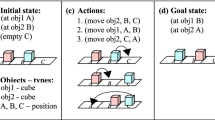Abstract
The evolution of production systems for smart factories foresees a tight relation between human operators and robots. Specifically, when robot task reconfiguration is needed, the operator must be provided with an easy and intuitive way to do it. A useful tool for robot task reconfiguration is Programming by Demonstration (PbD). PbD allows human operators to teach a robot new tasks by showing it a number of examples. The article presents two studies investigating the role of the robot in PbD. A preliminary study compares standard PbD with human–human teaching and suggests that a collaborative robot should actively participate in the teaching process as human practitioners typically do. The main study uses a wizard of oz approach to determine the effects of having a robot actively participating in the teaching process, specifically by controlling the end-effector. The results suggest that active behaviour inspired by humans can lead to a more intuitive PbD.



















Similar content being viewed by others
Explore related subjects
Discover the latest articles and news from researchers in related subjects, suggested using machine learning.References
Akgun B, Cakmak M, Yoo JW, Thomaz AL (2012) Trajectories and keyframes for kinesthetic teaching: A human-robot interaction perspective. In: Proceedings of the seventh annual ACM/IEEE international conference on Human–Robot interaction, ACM, pp 391–398
Alexandrova S, Cakmak M, Hsiao K, Takayama L (2014) Robot programming by demonstration with interactive action visualizations. In: Proceedings of robotics: science and systems (RSS 2014), Berkeley, USA
Antonsson E, Mann R (1985) The frequency content of gait. J Biomech 18(1):39–47
Argall B, Sauser E, Billard A (2010) Policy adaptation through tactile correction. In: Proceedings of the 2010 convention of the society for the study of artificial intelligence and simulation of behaviour (AISB 2010), Leicester, United Kingdom
Biggs G, MacDonald B (2003) A survey of robot programming systems. In: Proceedings of the Australasian conference on robotics and automation (ACRA 2003), Brisbane, Australia
Billard A, Calinon S, Dillmann R, Schaal S (2008) Robot programming by demonstration. In: Springer handbook of robotics, Springer, pp 1371–1394
Calinon S, Guenter F, Billard A (2007) On learning, representing, and generalizing a task in a humanoid robot. Neural Netw 37(2):286–298
Chaudhuri B (1996) A new definition of neighborhood of a point in multi-dimensional space. Pattern Recogn Lett 17(1):11–17
Dillmann R, Kaiser M, Ude A (1995) Acquisition of elementary robot skills from human demonstration. In: Proceedings of the international symposium on intelligent robotics systems (SIRS 1995), Pisa, Italy
H Kagermann WW, Helbig J (2013) Recommendations for implementing the strategic initiative Industrie 4.0: Final report of the Industrie 4.0 working group. Produktion, Automatisierung und Logistik
Halbert DC (1984) Programming by example. Ph.D. thesis, University of California, Berkeley, USA
Inamura T, Kojo N, Inaba M (2006) Situation recognition and behavior induction based on geometric symbol representation of multimodal sensorimotor patterns. In: Proceeding of the 2006 IEEE/RSJ internationl conference on intelligent robots and systems (IROS 2006), Beijing, China
Ito M, Noda K, Hoshino Y, Tani J (2006) Dynamic and interactive generation of object handling behaviors by a small humanoid robot using a dynamic neural network model. Neural Netw 19(3):323–337
Kang SB, Ikeuchi K (1995) A robot system that observes and replicates grasping tasks. In: Proceedings of the 1995 IEEE international conference on computer vision (ICCV 1995), Boston, USA
Kormushev P, Calinon S, Caldwell DG (2011) Imitation learning of positional and force skills demonstrated via kinesthetic teaching and haptic input. Adv Robot 25(5):581–603
Lambrecht J, Kleinsorge M, Rosenstrauch M, Krüger J (2013) Spatial programming for industrial robots through task demonstration. Int J Adv Robot Syst 10(5):254
Liu S, Asada H (1993) Teaching and learning of deburring robots using neural networks. In: Proceedings of the 1993 IEEE international conference on robotics and automation (ICRA 1993), Atlanta, USA
Lucke D, Constantinescu C, Westkämper E (2008) Smart factory—a step towards the next generation of manufacturing. In: Manufacturing systems and technologies for the new frontier: The 41st CIRP conference on manufacturing systems, Tokyo, Japan
Massa D, Callegari M, Cristalli C (2015) Manual guidance for industrial robot programming. Ind Robot Int J 42(5):457–465
Pais AL, Argall BD, Billard AG (2013) Assessing interaction dynamics in the context of robot programming by demonstration. Int J Soc Robot 5(4):477–490
Suay HB, Toris R, Chernova S (2012) A practical comparison of three robot learning from demonstration algorithm. Int J Soc Robot 4(4):319–330
Tung CP, Kak AC (1995) Automatic learning of assembly tasks using a DataGlove system. In: Proceeding of the 1995 IEEE/RSJ international conference on intelligent robots and systems (IROS 1995), Pittsburgh, USA, vol 1
Yang J, Xu Y, Chen CS (1994) Hidden Markov model approach to skill learning and its application to telerobotics. IEEE Trans Robot Autom 10(5):621–631
Acknowledgements
The authors would like to thank the teachers and students of the vocational education and training schools “Centro Oratorio Votivo, Casa di Carità, Arti e Mestieri, Ovada” and “Istituto Tecnico Industriale Statale Italo Calvino, Genova” for their contribution to the drafting and execution of the experiments.
Funding
This work has been supported by the European Union Erasmus+ Programme via the Master programme European Master on Advanced Robotics Plus (EMARO+).
Author information
Authors and Affiliations
Corresponding author
Ethics declarations
Conflict of Interest
The authors declare that they have no conflict of interest.
Additional information
Publisher's Note
Springer Nature remains neutral with regard to jurisdictional claims in published maps and institutional affiliations.
Rights and permissions
About this article
Cite this article
Carfì, A., Villalobos, J., Coronado, E. et al. Can Human-Inspired Learning Behaviour Facilitate Human–Robot Interaction?. Int J of Soc Robotics 12, 173–186 (2020). https://doi.org/10.1007/s12369-019-00548-5
Accepted:
Published:
Issue Date:
DOI: https://doi.org/10.1007/s12369-019-00548-5
Keywords
Profiles
- Alessandro Carfì View author profile




